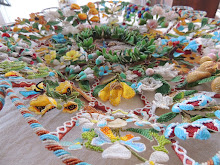1780 Brown Jean Stays/Corset 248.2004.01
This week's Museum Monday lucky number is 248! This late 18th c corset, or 'stay' as they were commonly referred to as, is a true work of art. After examining one up close and holding it in ones hands, it is easy to understand why the majority of stay makers in the 18th c were men~ they are heavy, all hand stitched thru layer upon layer of linen and whalebone....something that needed strong hands to accomplish. This era of stays do not lie flat when placed on a table...their shape is like a funnel or ice cream cone, both on and off the body! The cream silk ribbons center front are merely decorative, and have been laced thru the stitching along the center front seams.
The outer fabric is a chocolate brown jean with linen lining. Shoulder straps tie thru single eyelet holes near the underarm side seam, which would keep the straps tight on the arm, pulling the shoulders up and back to achieve proper posture. Waist is tabbed to provide ease over the hips and a nice snug glove like fit. Stitching of the whalebone channels can be seen, with direction carefully placed on the diagonal, wrapping around the wearers torso, making wear very comfortable. Along the chest edge, horizontal whalebone strips can be seen.
The linen lining is attached only at the edge seams, with body cut from a single piece. The tabs have been cut separately and seamed on across their tops, the whole lining appearing to hover above the actual surface of the stays.To really appreciate the workmanship and skill involved in stitching a set of stays, one really needs to get their nose up close~ here the shoulder strap lining can be seen, as well as the inside of the center back closing. A contrasting cream linen thread has been used, so each and every stitch can be seen, and was meant to be seen. The hand stitched eyelets are wonderful.
Inside lining at the underarm~ one can see slight perspiration staining, and see how close the shoulder strap hole is to the underarm? The placement of this hole was key in a proper fit for the upper body, to really get the shoulders drawn back, and push the bosom up. If one did not have a perfect fit here, in the cut of their stays, this area would dig into the body and cause painful chaffing~ the next time you have a chance to examine an 18th c corset, check to see if there is wear in this area~ you may even see some that have been cut out here and restitched.
Minute perfect little stitches for each and every whalebone channel~ while the stitching reaches all the way to the edge binding, the whalebone is cut short, with a single stitch placed in the center of each channel to keep the bones from shifting.





























6 comments:
Wow. I can't imagine having to live in one of these. The fit had to have been perfect, but so stiff! When you look at clothing from Walmart and compare the quality, we have really lost a lot over the years, but I still wouldn't want to wear this.
I echo everything Janice said but i'd love to try one on to see what it feels like...extrordinary, thanks for sharing ! And I'd like to enter #478 please !
Thankyou Diane~ I will add your number to the mix! In my personal experience, I find that 18th c stays are quite comfortable, aside from the shoulder straps, which do really pull the shoulders up and back, giving the wearer the exact posture as seen in 18th c paintings, with shoulders back and arms held slightly out and bent at the elbow.(Which is why I see so many reenactors wearing their 18th c stays without the shoulder straps) I have worn 17th , 18th and 19th c reproduction stays/corsets, and if worn correctly, with corset made to fit ones own measurements, they really are comfortable, and give great support to the spine. (Problems occur when people try and lace them to tightly to achieve a small measure of waist) 17th & 18th c stays give a great *illusion* of a smaller waist, without actually constricting so much, just by their cut and position on the body.
My mind boggles at the fineness of the stitching.
#300
Vivian
Hi Rachael, thank you so much for the details you gave, it was very eye-opening ! I can't get enough of history, historic dress, and needlework ! I can go on...!
Absolutely fabulous!!! Thanks for doing these Museum Mondays...Yes, I know it's Wednesday today, but I really do enjoy seeing the wonders of your collection when I can stop in for a visit...
Post a Comment